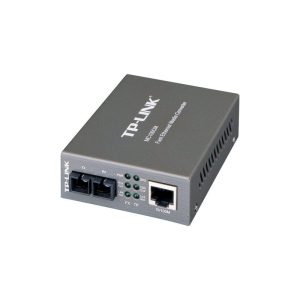Media Converters
Showing the single result
Buy media converters for the best price in Kenya only at Dove Computers.
Media converters are devices that connect two different types of media or network segments together. These devices are often used in situations where different types of network technologies are used, or when it is necessary to extend the distance of a network connection beyond the limits of a standard Ethernet cable.
This device typically has two network interfaces: one for the incoming data and one for the outgoing data. The incoming data is typically received in one format, such as fiber optic or coaxial cable, and the media converter converts it to another format, such as Ethernet.
They come in a variety of form factors, including standalone devices, rack-mountable units, and modules that can be inserted into a larger chassis. Some media converters are powered by an external power supply, while others can be powered over Ethernet.
They can be used to connect different types of devices, including switches, routers, and servers. Visit Dove Computers for amazing offers on media converter
Types of media converter
- Copper-to-fiber converters: These devices convert Ethernet signals from copper cables to fiber optic cables, allowing for longer transmission distances and reducing electromagnetic interference.
- Fiber-to-fiber converters: These converters allow two different types of fiber optic cables to be connected together, allowing for longer distances to be covered or different types of fiber optic cables to be connected.
- Serial-to-fiber converters: These devices convert serial signals, such as RS232 or RS485, to fiber optic signals, which can be transmitted over longer distances.
- Ethernet-to-coax converters: These devices allow Ethernet signals to be transmitted over coaxial cables, which can be useful in situations where existing coaxial cables are already installed.
- Wireless-to-wireless converters: These devices allow wireless signals to be converted to other wireless frequencies or protocols, allowing for different types of wireless networks to be connected together.
- Media converter switches: These devices combine the functionality of a media converter with that of a network switch, allowing for multiple devices to be connected and managed through a single device.
Forms of media converters
- Chassis: Enterprise networking has transformed over the years. This has brought various changes in the cabling. Some applications like data converters, LAN wiring closets, and switching rooms use many cables, which are terminated at various places to ensure network connectivity. Chassis-based media converters are used for these applications. These media converters support high-density conversion in areas, where flexibility is required to mix and match different types of cables and networks.
- Slide-in Media Converter Cards: These slide-in media converter cards are named so because they are slid into the chassis to ensure flexibility. Slide-in media converter cards draw power from the chassis and they feature egress and ingress ports to meet the needs of the network.
- Standalone: The media converters are used to meet the cabling need of non-IT applications. They can be used to connect a remote workstation or an access point that is wireless. Standalone media converters can meet diverse networking requirements. They are equipped with features like auto-MDI/MDIX, auto-negotiation, and an active link pass through. These converters also feature automatic link restoration that enables quick network restoration.
Media converter modes
- Single-Mode Media Converter: This media converter mode is also known as a transverse mode. They transmit light signals in only one direction. Single-mode media converters have low attenuation because they have core diameters that range from 9 microns up to 10.5 microns.
- Multi-Mode Media Converters: In contrast to single-mode media converters, these media converters transmit signals in two or more directions. Multi-mode media converters have high light dispersion and authentication rates due to core diameters that range in the neighborhood of 50 to 62.5 microns.


